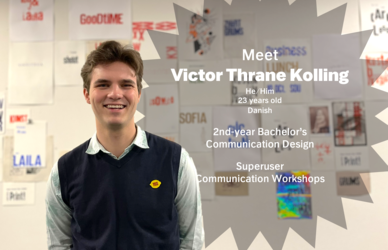Søren has created a coffin out of fungi roots in order to remind us that death is natural
Death. The most natural phenomenon in the world, the way we are all heading – without exception. Nevertheless, death is surrounded by a multitude of taboos, and many of us try to distance ourselves to death through language, action and objects. One example is the coffin, which is the focal point of most funerals and burials: most often it is a polished wooden piece of furniture with sharp lines and perhaps a single carved garland signalling anything but naturalness.
Søren Overgaard, a newly graduated Bachelor in Industrial Design from Design School Kolding, wants to change that.
- I want to alter people’s expectations of what a coffin should look like and what materials it should be made of. By and large, the design of the coffin we know today has not changed in the last 500 years, and it is my belief that what we do is we’re hiding death rather than recognizing the beauty of death – sure enough a life is ending, but in return we become part of a new cycle.
Sarcophagus made of fungal material
Søren has therefore created a coffin that poses a challenge both in terms of form and of materials. Instead of the traditional box shape, he has chosen an organic shape, inspired by the classic sarcophagi we know, for example, from ancient Egypt. It is reminiscent of the silhouette of a person, not because the designer intends to provoke or shock, but rather, with the soft idiom, wants to invite people to remember the person lying in the coffin.
However, it is with his choice of material that Søren definitively distances himself from the traditional coffin having selected to use mycelium as the most important component of the coffin.
- Mycelium is the root system from which fungi grow. It is an entirely organic material that absorbs nourishment from dead material such as old wood or, in this case, hemp fibres. I mix the fibres with fungal spores and add the mixture to a fiberglass mould. The coffin will grow out in just a week – without the use of heat, electricity or any other form of energy. The mycelium that emerges secretes a kind of glue, called chitin, which binds the coffin together. When the coffin has reached the desired size, I end the process and let the material dry out so that the coffin becomes completely solid. After the interment, the coffin will absorb moisture from the soil, and subsequently the natural processes will decompose the deceased much faster than usual, and the body will thus be incorporated into nature's own cycle, says Søren.
The sustainable funeral
With his coffin, Søren wants to present a sustainable alternative to the coffin produced by the traditional funeral industry. The coffin will appear entirely natural and simple, without decorations – or handles, for that matter. Therefore, a kind of stretcher has also been designed which the undertaker can reuse for the next funeral.
- I do not imagine that the coffin should be available in different colours or with optional decorations. Today, just hours after the passing, relatives have to make decisions, based on the undertaker's catalogue, regarding which models and varnishes and screws they want to spend money on. I really want to eliminate all these choices and minimize the business aspect of death, he says.
Like a butterfly in the pupa
Søren Overgaard has chosen to call his project Mnemosyne, named after the Greek goddess of remembrance. In addition, Mnemosyne is also the name of a butterfly, which unfortunately is extinct in Denmark today. And it is actually the butterfly and its life cycle that have been an inspiration from the very outset.
- As you know, in its growth cycle, the butterfly develops inside a pupa in the phase from larva to butterfly. And if you stretch your imagination the shape of my coffin may well resemble a pupa. So somehow, I believe the name makes really good sense. This is where the change takes place, and the deceased arrives at a new destination in the endless cycle of life.
-------------
Søren Overgaard
Bachelor in Industrial Design June 2022, Design School Kolding.
The project in summary
Although death is one of the most natural phenomena in the world, our culture forces us to make death something unnatural, for example by concealing the deceased in a chipboard box. The designer wants to bring death closer to nature, and he has therefore reinvented the traditional coffin. It will be made exclusively of mycelium, the white root system of fungi, which is both a very strong but also very light material. In addition, the coffin will quickly be reduced to compost, and so will the deceased. But the memory of the person who passed away remains strong, and that is why the coffin is named after Mnemosyne – the goddess of memory.
About mycelium
Mycelium is the part of a fungus that is most often found below the earth's surface, where we primarily recognize the fruit body (sporocarp) of the fungus as the raw material we use in the kitchen. The mycelium forms widely branched root systems, and is thus said to constitute the largest living organisms on the planet. Mycelium grows on and converts dead, organic material without the need for additional energy, for example. Therefore, mycelium is considered one of the sustainable materials of the future and can be used as building materials, packaging, artificial leather and as food products, among other things.



